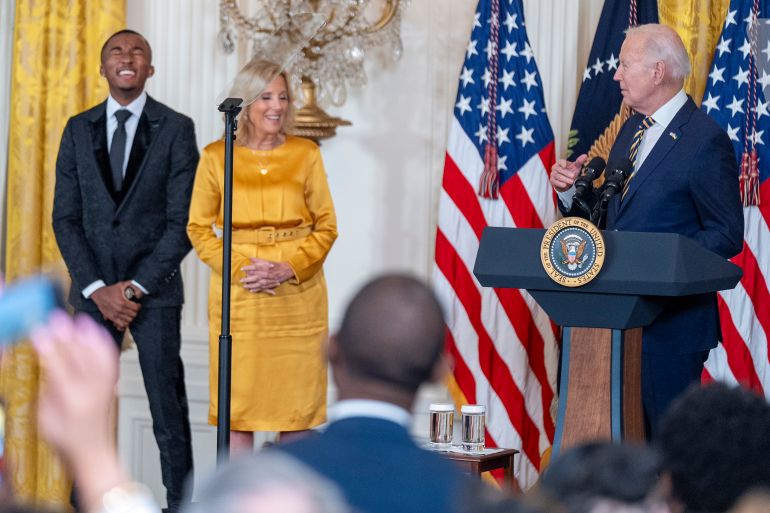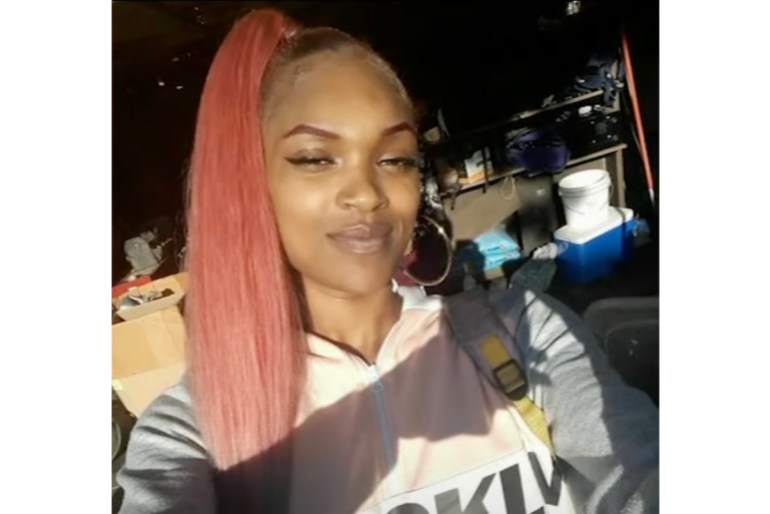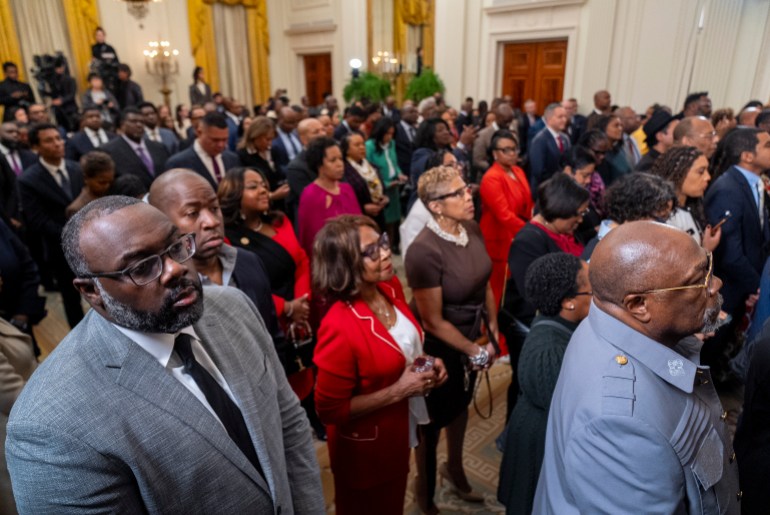Celebrating Black history while killing the Black body
African Americans say the annual commemoration obscures dark truths about Black life.

With United States Vice President Kamala Harris standing by his side, President Joe Biden hosted the annual Black History Month reception in the White House’s chandeliered East Room on February 6. Addressing a throng of Black politicians, civil servants and corporate leaders, he said:
“That’s the very idea of America – that we’re all created equal in the image of God” and “deserve to be treated equally throughout our lives”.
Twelve days later, family and friends of 27-year-old Niani Finlayson gathered at a memorial service for her inside the spare chapel of Funeraria Del Angel, 5,000km (3,000 miles) from Washington, DC. Even for those accustomed to grief, the service in Anaheim, California, was especially wrenching. The single mother of two and home healthcare worker was fatally shot by a Los Angeles sheriff’s deputy after she called the 911 emergency number for help in a domestic dispute with her ex-boyfriend.
Among those sitting in the chapel’s honey-coloured pews was her father, Lamont Finlayson, “a Black man of a certain generation who you can imagine doesn’t cry often”, said the activist and scholar Melina Abdullah, who attended the service. “But he was wailing and wailing for his daughter,” she told Al Jazeera, “and for what she meant to her daughters”.
The stark contrast between the White House gala and Finlayson’s killing shines a light on the yawning gap between the glossy, performative quality of Black History Month, which concludes on Thursday, and the bleak reality faced on the ground by 47 million African Americans. Since a white Minneapolis police officer murdered an unarmed Black man, George Floyd, in May 2020, law enforcement officers in the US have slain more than 4,500 people, according to the research organisation Mapping Police Violence. That includes 1,353 people killed by police in 2023, the highest total since Mapping Police Violence first began compiling data in 2014.
And while African Americans account for 13 percent of the US population, they are nearly three times more likely to be killed by police officers than are whites, according to Mapping Police Violence. For every one million people, 77 Blacks are killed by police compared with 27 whites, 36 Hispanics and nine Asians.

Video from Finlayson’s fatal shooting showed Los Angeles Sheriff’s Deputy Ty Shelton firing on the woman four times within a few seconds of entering her home in the Anaheim suburb of Lancaster on December 8. Police and their defenders online argued that she was wielding a knife when she answered the door, but Finlayson’s family and supporters countered that the officers never appeared to be in imminent danger and it seems clear from the footage that she was only seeking to protect herself from her ex-boyfriend when she was gunned down in front of her nine-year-old daughter, who Shelton reportedly ordered to “clean up” her mother’s blood.
Finlayson’s killing is merely the latest in a string of African Americans brutalised by police in Los Angeles. The 1965 Watts riots began when an officer struck a 21-year-old motorist in the head with a police baton, and the 1992 riots followed a jury’s acquittal of four white police officers who were videotaped beating another African American motorist, Rodney King, with police batons. Years of bad blood between law enforcement and Black Angelenos undergirded jurors’ 1995 decision to acquit the American football Hall of Famer OJ Simpson of murdering his wife, Nicole Brown Simpson, and Ronald Goldman.
More recent cases include 31-year-old Keenan Anderson, an African American schoolteacher who was Tasered to death by police on a West Los Angeles street corner in January 2023, and Ryan Twyman, who was sitting unarmed in a parked car outside a South Los Angeles apartment complex in 2019 when police opened fire on him.
“When you talk about horrific cases, there are lots and lots of horrific cases,” said Abdullah, a professor of Pan-African studies at California State University in Los Angeles and director of Black Lives Matter Grassroots.
‘What does it mean to briefly choke someone?’
In the Black History Month proclamation issued by the White House this month, Biden seemed to acknowledge the ineffectiveness of his administration’s laissez-faire approach to criminal justice reform centred on retraining police to use nonlethal force and “shoot ’em in the leg”. Despite Democrats holding a slim majority in Congress in Biden’s first two years in the White House, his administration failed to pass even the watered-down George Floyd Justice in Policing Act of 2021. Instead, he signed an executive order “instituting key elements” of the act, including “banning chokeholds, restricting no-knock warrants by Federal law enforcement, and creating a national database of officer misconduct”.
Activists’ key demand to either modify or abolish the qualified immunity extended to police who abuse their authority was not included in Biden’s executive order, leaving 18,000 police agencies nationwide without much clarity.
In Washington, DC, many African Americans said that the contradictions inherent in celebrating Black history while continuing to spill Black blood imbues the month of February with a sense of foreboding or of being both “at the table and on the menu”, to repurpose a phrase spoken at a recent webinar by Washington, DC-based activist and scholar Maha Hilal, director of the Muslim CounterPublics Lab.
Similar to Los Angeles, which for decades has had a troubled relationship with its Black and Latino communities, Washington, DC, is also a tough nut for activists to crack, in part because of the byzantine maze of 32 independent law enforcement agencies in the US capital region. Each department, African American activists said, is a bit like its own puzzle that must be unlocked.
On February 6, the same day of the White House Black History Month commemoration, the Washington city council approved an omnibus crime bill that had permitted police to place “a brief hold” on the neck of a detainee, but that language was deleted after community pressure.
“What does it mean to briefly choke someone?” Frankie Seabron, lead organiser for the advocacy group Harriet’s Wildest Dreams, asked rhetorically as she stood inside the council chambers on February 6. “There are a lot of jurisdictions that ban chokeholds, so there’s no reason why they should not be banned here. It’s not safe.”
The lead organiser for Black Lives Matter DC, April Goggans, told Al Jazeera that she is still waiting for the release of police bodycam footage and answers in the death of Alaunte Scott, who was shot to death by US Marshals on February 28, 2023. The Marshals Service told reporters it tried to detain Scott for an alleged parole violation and the 22-year-old had a gun on him, but it remains unclear whether he fired the gun or even brandished it as the police closed in on him.
Harriet’s Wildest Dreams is also still waiting for answers in the slaying of 17-year-old Dalaneo “Debo” Martin, who was fatally shot by US Park Police as he slept in a parked car. Activists plan to hold a news conference at the US Department of Justice next month to commemorate a year since Martin was killed.
“Six shots to the back, and they still haven’t explained that,” NeeNee Tay, director of Harriet’s Wildest Dreams, posted in announcement of the news conference.
‘. . . to make some kind of statement’
Across social media and in barber shops and beauty salons, African Americans from all walks of life have noted that the pageantry of Black History Month obscures the ugliness of Black life in the US. It has not gone unnoticed by many African Americans that the same Biden, whose administration has repeatedly blocked Gaza ceasefire proposals at the United Nations, also led a chant of “Fund the police” at the 2021 State of the Union address in a rather stunning rebuke of activists’ demands to reduce, or de-fund, public spending on law enforcement agencies, which are widely regarded as occupying armies by racialised communities.

What typically goes unsaid in celebrations of Black History Month is that the nation is in the throes of a killing spree by whites who fear that they are being replaced by their darker-skinned neighbours. An FBI analysis of 2022 data found a sharp increase in hate crimes – from 10,840 in 2021 to 11,634 in 2022 – with more than half, or 52 percent, targeting African Americans.
Likewise, the Anti-Defamation League attributed 25 homicides to right-wing extremists in 2022, of which 21 were at the hands of white supremacists like Payton Gendron, an 18-year-old gunman who walked into a Buffalo, New York, grocery store and opened fire, killing 10 people and injuring three, all African Americans. And an analysis of the 377 Americans arrested or charged in the January 6, 2021, riots at the US Capitol found that 95 percent were white and the vast majority came from counties with shrinking white populations.
Scholars said the demographic shift in the US – coupled with the economic precarity ushered in by the Great Recession, which began in 2008 – has sparked a white backlash that is intended to keep African Americans in their place. Consider the attack on a 25-year-old African woman named Berlinda Nibo by a mostly white mob of nearly two dozen supporters of former President Donald Trump in Los Angeles on the same day of the Capitol Hill attack.
“It seemed like these people were trying to kill me to use me to make some kind of statement or something,” Nibo told the Los Angeles Times.
Compounding matters for Black activists fighting police violence is the growing class divide in the African American community, which has only widened in the years since President Barack Obama left the White House. It has become a common complaint among the nation’s Black working class and poor that the Black elite – as represented by the audience at Biden’s Black History Month gala, Vice President Harris, Secretary of Defense Lloyd Austin and US Ambassador to the United Nations Linda Greenfield-Thomas – have distanced themselves from the struggles of the broader African American community in an effort to ingratiate themselves with powerful whites.
Scenes like that in the White House’s East Room for Black History Month struck many African Americans as redolent of the famous admonition by civil rights leader Martin Luther King Jr that Blacks are integrating into a burning house.
“We call it black face on white supremacy,” said Abdullah, who through Black Lives Matter Grassroots and in partnership with the organisation Cancel the Contract has been assisting Finlayson’s family, who lacked resources for a traditional funeral or burial and cremated her remains. Finlayson’s two daughters, Kaisha and Kyla, are in the care of their grandmother.
“Since our arrival in this country, there have always been a few of us who’ve been willing to sell out the rest of us for some crumbs,” Abdullah added, “and so it’s really important that we challenge white supremacy and the oppression of Black people- whoever is moving those things.”